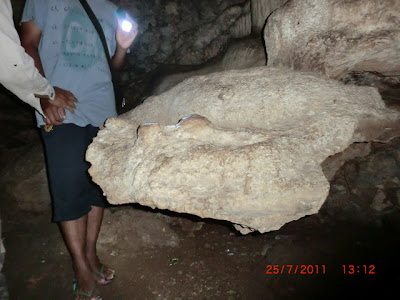 |
| Malioboro Road |
Paradise Souvenirs
 |
| souvenir |
 |
| Batik |
Enjoy the shopping experience, hunting souvenirs of Jogja, tourists can walk along the shoulder of the road corridor (arcade). Here you will find many vendors who hold merchandise. Ranging from local handicrafts such as batik, rattan ornament, leather puppets, bamboo handicrafts (key chains, decorative lamps, etc.) also blangkon (hat typical Java / Yogyakarta) and silver goods, to merchants who sell a lot of knick knacks general found in other trading places. Along the arcade, tourists can shop in peace in a sunny or rainy conditions, also can enjoy a pleasant shopping experience at bargain prices. If lucky, can be reduced by one third or even half.Do not forget to leave little energy. There is still a traditional market that should be visited. In the place known as Beringharjo market, but tourists can find similar goods are sold along the arcade, this market provides a variety of traditional products is more complete. In addition to local products Yogyakarta, also available product neighboring areas such as Pekalongan batik or batik Solo. Looking for batik or batik prints, or just looking for decorating the window curtains with unique motifs and batik bed sheets beautiful. This place will satisfy your shopping desires unique items with a cheaper price.Shopping in the area of Malioboro and Beringharjo, be sure not to be fooled by the price offered. Usually the sellers to raise prices than usual for tourists.
Vredeburg and Gedung Agung (Great House)
 |
| Vredeburg Fort |
 |
| Great House |
While the Great House is located in front of him had been the residence of the Head of the Dutch colonial administration from 1946 until 1949. In addition he became the Presidential Palace during Sukarno's presidency when the State Capital was moved to Yogyakarta.
Lesehan Malioboro
 |
| Lesehan |
As the sun began to set, when the street lights came on and the shops that add beautiful ambience Malioboro, one by one lesehan shanties sprung. Food of Jogja such as warm or pecel catfish can be enjoyed here in addition to oriental cuisine or sea food and cuisine of Padang. Entertainment as well as hits or memorable song by the other street when dining.For tourists who want to taste the cuisine along the way Malioboro, ask for price list and make sure the seller, to avoid rising prices are not reasonable.Visiting Yogyakarta is known as the "Living Museum Javanese Culture", feels incomplete without a stop at the road that has kept many stories of struggle of Indonesian history and filled with a variety of souvenirs. A paradise for lovers of history and souvenir hunters.
 |
| Gudeg Yogyakarta |
Places of Interest (radius of 1 km from Malioboro)
HOTEL BHINNEKA (0.5 km)
HOTEL PETI MAS (0.3 km)
PACTO (0.3 km)
GREAT TOUR (0.3 km)
PASAR BERINGHARJO (0.6 km)
SOSROWIJAYAN (0.3 km)
SOSROKUSUMAN (0.1 km)
ANGKRINGAN LIK MAN (0.5 km)
STASIUN TUGU (0.5 km)
PABRIK TEGEL KUNCI (1.1 km)
NASI GORENG BERINGHARJO (0.9 km)
PECINAN (0.5 km)
LOJI (1 km)
KOTABARU (1.2 km)
BLUE EARTH (0.9 km)
BIOSKOP PERMATA (1.3 km)
HOTEL KRISTINA (0.4 km)
BARUMUN MONEY CHANGER (0.3 km)
ABADI HOTEL JOGJA (0.4 km)
SAKANTI CITY HOTEL (0.7 km)
THE SRIKANDI HOTEL (1 km)
TAMAN PINTAR YOGYAKARTA (0.9 km)
HOTEL 1001 MALAM (0.3 km)
RUMAH BOEDI PAVILION (0.7 km)
TEGAL PANGGUNG GUEST HOUSE (0.6 km)
HOTEL JENTRA DAGEN (0.4 km)
HOTEL BATIK YOGYAKARTA (0.2 km)
BALUMBA TOURS (0.2 km)
PESTA PERAK RESTAURANT (1.1 km)
LEGIAN GARDEN RESTAURANT (0 km)
Where to Go (radius 5 km dari MALIOBORO)
TAMANSARI (2 km)
KOTAGEDE (5.4 km)
SASANA WIRATAMA (1.7 km)
MUSEUM SASMITALOKA (1.5 km)
MONUMEN JOGJA KEMBALI (MONJALI) (4.8 km)
KRATON YOGYAKARTA (1.5 km)
KAMPUNG KAUMAN (1.3 km)
MASJID KOTAGEDE (5.4 km)
DUSUN MLANGI (5.2 km)
PASAR BERINGHARJO (0.6 km)
SOSROWIJAYAN (0.3 km)
SOSROKUSUMAN (0.1 km)
PRAWIROTAMAN (3 km)
TERMINAL GIWANGAN (5.4 km)
STASIUN TUGU (0.5 km)
PABRIK TEGEL KUNCI (1.1 km)
PABRIK GULA MADUKISMO (4.6 km)
PECINAN (0.5 km)
MUSEUM AFFANDI (3.5 km)
LOJI (1 km)
KOTABARU (1.2 km)
BINTARAN (1.5 km)
KAMPUNG SERANGAN (1.6 km)
MUSEUM SONOBUDOYO (1.1 km)
TUGU JOGJA (1.1 km)
SELOKAN MATARAM (3.3 km)
PANGGUNG KRAPYAK (3.9 km)
WARUNGBOTO (3.6 km)
BIOSKOP PERMATA (1.3 km)
TAMAN PINTAR YOGYAKARTA (0.9 km)














